- By Dan Veaner
- Around Town
 Print
Print 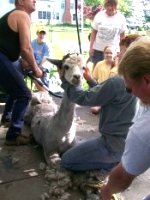 If you only got one haircut per year you would want it to count for something. And that's exactly what the Engels family does each spring when it it time to shear their alpaca at Angel Tree Farm in Lansing. With a growing herd, the haircuts add up -- this spring they sheared 19 of their 21 alpacas, and 4 more for people they have sold animals to. "People drive by now and think we are raising a different kind of animal!" says Angel Tree's Ellie Hunter. "It went well but we now have some pretty funny looking animals."
If you only got one haircut per year you would want it to count for something. And that's exactly what the Engels family does each spring when it it time to shear their alpaca at Angel Tree Farm in Lansing. With a growing herd, the haircuts add up -- this spring they sheared 19 of their 21 alpacas, and 4 more for people they have sold animals to. "People drive by now and think we are raising a different kind of animal!" says Angel Tree's Ellie Hunter. "It went well but we now have some pretty funny looking animals."Shearing an alpaca herd is a big production. "To get ready for shearing, you have to start at least two days ahead of time," Hunter says. "You have to make sure they don't get wet. Then you start to hand-pick the major stuff like hay out of them because that will jam the razor that he's using. Then the next thing you do is you vacuum them with a vacuum cleaner."
Shearing alpaca is a specialized task. While the family and some friends helped create an assembly line, the family hired Certified Shearer Tom Horton of Towanda, PA to do the actual shearing. The trick is to shear the wool in one pass, so you don't get shorter fibers by cutting a second time. This means the animal has to be secured and calm, so quite a few people help hold the alpaca, sort the wool based on what part of the animal it came from, and bag and label the wool with the animal's name.
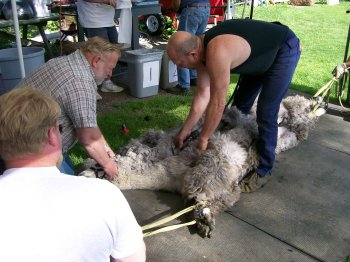
Tom Horton shearing an alpaca
"I stood back for a minute and counted," Hunter says. "There were 10 people around an animal while it's being sheared because there are two on each side, and then you've got three bins marked 1, 2, and 3. Depending upon where the fleece comes from the animal it's either a 1, 2, or 3. And then it's bagged and marked with their name and what number it is. And we had them in order of what we wanted to do them so the minute one was done, he's yelling 'Next' and zoom another one's in there. He plans on 20 minutes a piece and does it really fast."
Hunter was one of the people pulling the wool out of the way so it wouldn't be cut again. "As he shears, you try to pull the wool away so he doesn't cut it a second time," she says. "That is how I lost the end of my finger. I got my finger caught. It was my own fault, I was rushing."
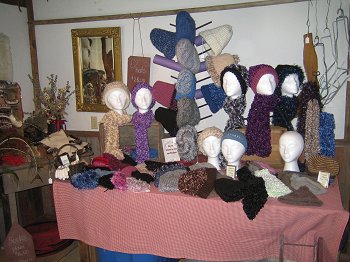
Hats with matching scarves and mittens are among the products
produced from the alpacas at Angel Tree Farm
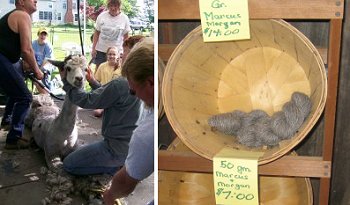
Wool is labeled with the name of the animal it came from so you
can buy products made from animals you see at the farm
Hunter and husband Mal are Carol Engels' parents. Carol and husband Jay raise the animals along with their children Ashley and Tyler and the Hunters. In just a few years they have grown their herd to an impressive 21 alpacas, along with a pair of guard llamas, and a slew of chickens. Everyone gets into the act with Carol giving them shots and medical care, Jay taking care of the business end, and Ashley showing their animals at alpaca shows. Hunter knits many of the products sold in their shop, a converted blacksmith shop on the farm. "There's a lot of work that goes into it," she says. "And then the knitting takes time so if you charge $25 for a pair of mittens or a hat, you still aren't making an awful lot. And my labor is free!"
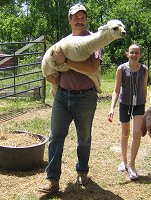
Lucky, with Jay and Ashley
The newest addition to the herd won't get his first hair cut until next year. Only four weeks old, Lucky got his name because he survived a very difficult birth. "He is lucky to be alive!" Hunter says. "Thankfully the vet got here in about 20 minutes and saved not only the baby but his mom."
Lucky and his mom don't seem the worse for wear. And Mom looks positively svelte in her new hair-do.
----
v3i22



